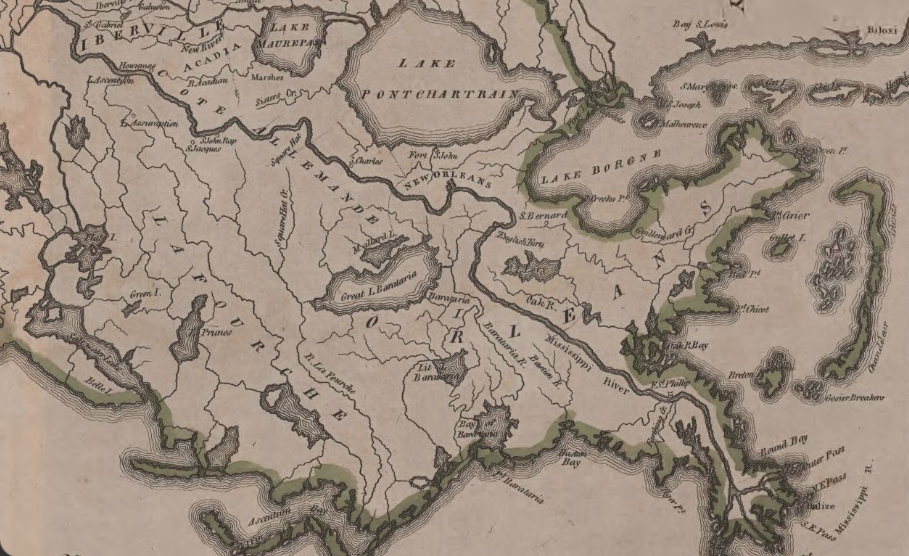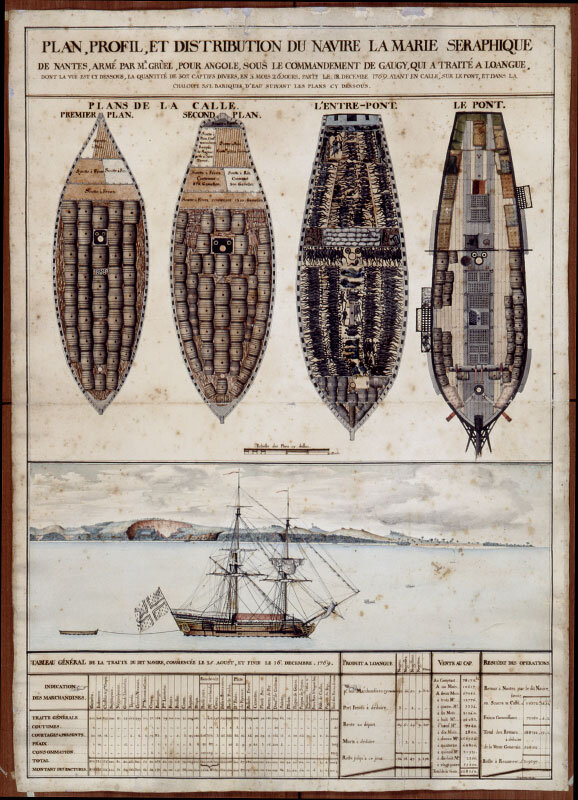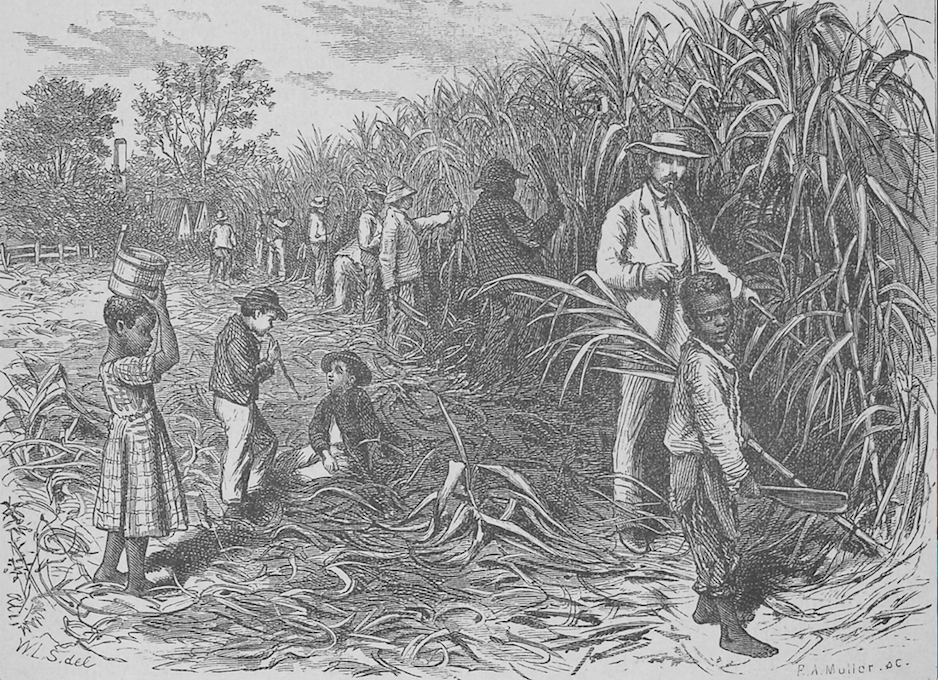The Heidels (Haydels), founders of Evergreen Plantation, were among the first settlers of Louisiana’s German Coast. Located upriver from New Orleans, the Côte des Allemands, as the French called it, was home to Germans attracted to Louisiana by John Law’s campaign to help settle the struggling colony in 1721. John Law was the head of the Company of the Indies, which was overseeing colonial Louisiana. In an effort to help settle the colony and make it economically viable, Law sought agricultural workers to farm his landholdings, known as concessions. Law distributed pamphlets that described Louisiana as a paradise, a land of opportunity where newcomers could thrive. This appealed to a struggling population in areas of Germany, Switzerland, and Alsace-Lorraine, an area that had both German and French influences. They had been demoralized by war and their land forcibly taken from them. They looked to Louisiana to start a new life.
Unfortunately Law’s idyllic portrait of Louisiana proved false. From the start, the Germans faced serious hardship. Disease and death characterized their journey aboard the “Pest Ships” that transported them to Louisiana. Six thousand Germans left French ports for Louisiana. Only two thousand survived the voyage. Upon arrival, they discovered that Louisiana possessed a brutal climate, was disease-ridden, and lacked basic food and supplies. Law was a fraud, and the Company of the Indies a failure.
Yet the Germans made the best of things and set to work establishing small farms that would ultimately be successful. They soon began bringing their produce to market in New Orleans. Many believe that the Germans’ food supply prevented residents of the city from starving. Without their hard work, the colony would not have survived.
A letter written by a German immigrant in 1802 provides a glimpse of life on the German Coast just prior to the Louisiana Purchase. It is unique in that it was written by a German drawn to the colony long after the initial wave of Germans had arrived. Johann Joachim Lagemann, born in Germany in 1757, emigrated to America in 1785. His brother Heinrich Peter Lagemann had been charged with paying for Johann’s university studies, but the money did not arrive regularly. This made it impossible for him to continue his studies and probably led to his decision to travel to Louisiana to seek other opportunities. He found an already well-established community on the German Coast, where the early settlers had intermarried with French and later Acadians.
Several years after he arrived in Louisiana, he wrote to his brother of his marriage, his new home, and his impressions of Louisiana. What follows is a transcription of his letter.
From Mathew Carey's "General Atlas;" one of the first maps of Louisiana after statehood in 1812, Louisiana State Museum Historical Map Collection.
Beloved Brother, and remaining relatives and friends;
One other thing I must let you know: that I am still alive, where I live and that (thank God!) My present circumstances are very bearable. I live on the Mississippi, 13 hours over New Orleans. (Lat: 30N, Long: 2.16 E). Northside of the river, Cote des Allemans [German Coast], paroisse St. Jean Baptiste [St. John the Baptist parish].
February 28, 1800 I was married to Catharina Vickner, widow Marchand, with two children: Johann Baptist, age 7 and Catharina age 4 and a wealth of 15000, and what’s more, we live in unity and happiness together. Nov. 28 my daughter Magdalene Celeste was born.
My wife’s father Adam Vickner, her mother Margareta Tracgern, both are out of two of the first and most numerous families here.
As I write this, we are subject to Spain, free from all taxes and tributes, and are bothered by nothing, since all are a member in the militia for our own safety, because of the blacks, for there is degradation of the human soul here: slavery-----we have only 5 black slaves, who work the fields, and 4 little ones, some have hundreds.
The fields yield: rice, Indian corn, Indigo, sugar, cotton, fruits, as you know it in Germany there is none, only oranges, peaches and figs. Garden-produce is available year-round. Caterpillars and other damaging insects are great inconveniences. The great heat in summer, the quick change of the weather are dangerous to health and life, especially to foreigners.
All tradesmen are free, everybody does what he can.
The only salvation providing religion is only a shadowplay here of the true Roman Catholic. No other church has public service; but freedom of conscience goes into the widths, even into the crazy.
The true spirit of commerciality reigns supreme! The right and moral value of a person is measured by the size of his moneybag—the scoundrel who can deceive and cheat most is called a “Homme bien poli” that is, a man, who knows hot to live.
What is called rightfully pressing poverty, does not exist, thank God! Everyone can make enough to get by,—slavery is barbarical enough, but not as tyrannical as the unfortunate serfdom in the civilized Holstein by far. For the nights and the Sundays are for them, and necessary clothing and board have to be given them, yet happy is the land that knows no slavery, for it is a pest for morals, insolence, stealing, and all shame and vice are rampant among the people—they are slaves and make their masters into slaves too, or relentless, unmerciful barbarians and avengers.
The main language is French, English, Spanish, German, Cathalone is spoken too.
I never did write, and I suppose I have been forgotten long ago, but I still mean to take a trip to Germany, but I am and will never be well at sea—so I fear my illness more than the sea, and my wife shows much reluctance—the otherworld will reunite us. . . .
Aux Allemans
March 1, 1802
Johann Joachim Lagemann
***Johann Joachim Lagemann’s letter can be found in the Manuscripts holdings of the Louisiana Division at the main branch of the New Orleans Public Library.
Tomb of Anastasie Lagemann Rodrigue, Johann Lagemann’s daughter, St. John the Baptist Catholic Church cemetery, Edgard, Louisiana.



